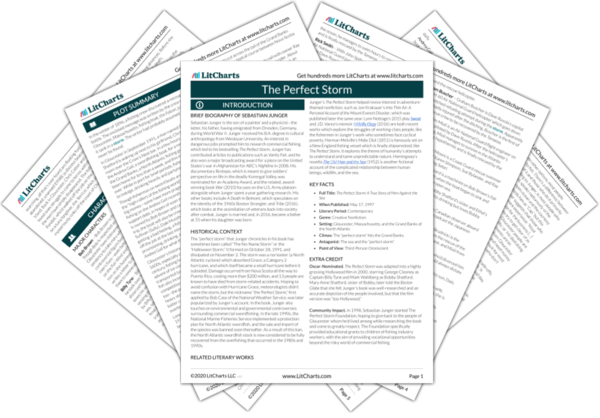Welcome to the LitCharts study guide on Sebastian Junger's The Perfect Storm. Created by the original team behind SparkNotes, LitCharts are the world's best literature guides.
The Perfect Storm: Introduction
The Perfect Storm: Plot Summary
The Perfect Storm: Detailed Summary & Analysis
The Perfect Storm: Themes
The Perfect Storm: Quotes
The Perfect Storm: Characters
The Perfect Storm: Terms
The Perfect Storm: Symbols
The Perfect Storm: Theme Wheel
Brief Biography of Sebastian Junger

Historical Context of The Perfect Storm
Other Books Related to The Perfect Storm
Key Facts about The Perfect Storm
- Full Title: The Perfect Storm: A True Story of Men Against the Sea
- When Published: May 17, 1997
- Literary Period: Contemporary
- Genre: Creative Nonfiction
- Setting: Gloucester, Massachusetts, and the Grand Banks of the North Atlantic
- Climax: The “perfect storm” hits the Grand Banks.
- Antagonist: The sea and the “perfect storm”
- Point of View: Third-Person Omniscient
Extra Credit for The Perfect Storm
Oscar-Nominated. The Perfect Storm was adapted into a highly grossing Hollywood film in 2000, starring George Clooney as Captain Billy Tyne and Mark Wahlberg as Bobby Shatford. Mary Anne Shatford, sister of Bobby, later told the Boston Globe that she felt Junger’s book was well-researched and an accurate depiction of the people involved, but that the film version was “too Hollywood.”
Community Impact. In 1998, Sebastian Junger started The Perfect Storm Foundation, hoping to give back to the people of Gloucester whom he’d lived among while researching the book and come to greatly respect. The Foundation specifically provided educational grants to children of fishing industry workers, with the aim of providing vocational opportunities beyond the risky world of commercial fishing.







